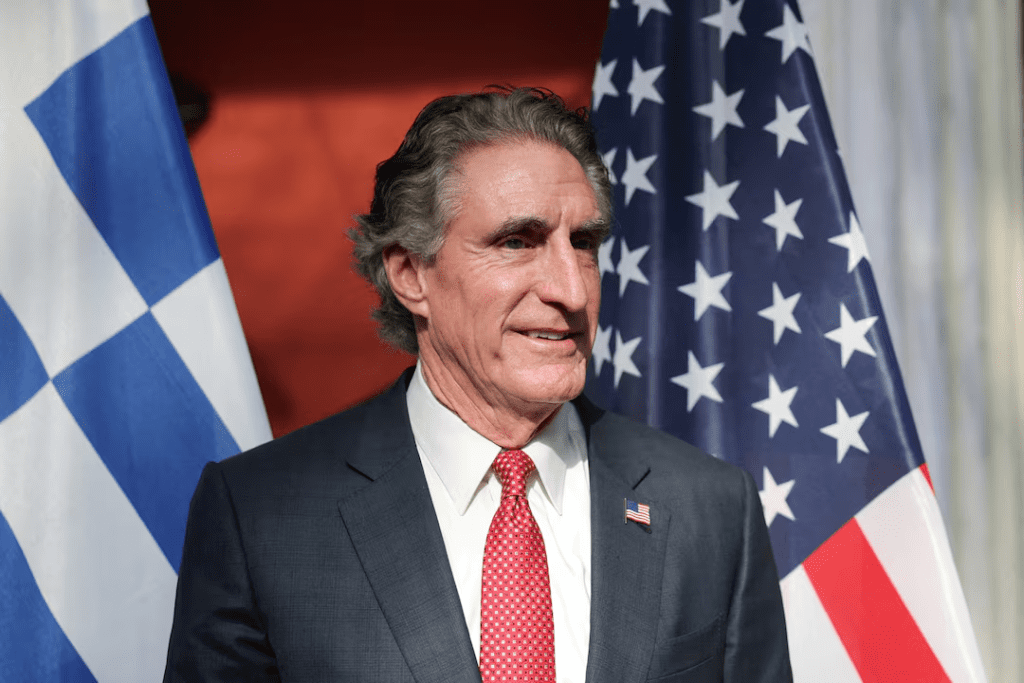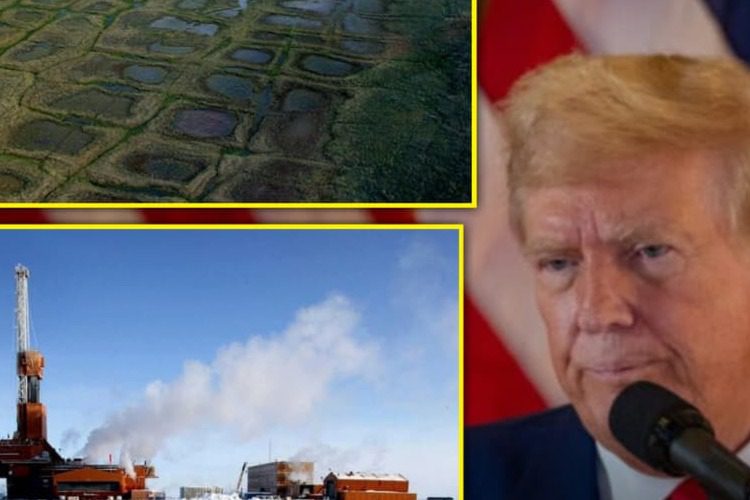From Biden’s Lockdown to Trump’s Liberation: President Unleashes 13 Million Acres of Alaskan Oil Reserve in Epic Energy Reversal – Promising Cheaper Gas, Jobs, and a Brighter Future for American Families
In the vast, whispering wilderness of Alaska’s North Slope, where the midnight sun casts eternal gold on permafrost prairies and caribou herds roam like ghosts of ancient migrations, a single executive order on November 13, 2025, cracked open the door to a new dawn—one that echoes the unyielding spirit of a nation ready to reclaim its strength. Picture the grizzled oil worker in Prudhoe Bay, his face weathered by decades of subzero shifts, wiping frost from his beard as he hears the news crackle over his radio: President Donald J. Trump has revoked the Biden-era restrictions that chained 13 million acres of the National Petroleum Reserve to bureaucratic red tape, unleashing half of the state’s largely untouched energy frontier for exploration and extraction. It’s the kind of moment that doesn’t just shift policy—it stirs the soul, a fulfillment of Trump’s campaign thunder that “drill, baby, drill” would bring down prices at the pump and put paychecks back in pockets. For families like the Johnsons in Anchorage—Sarah, a nurse pulling doubles to cover rising utility bills, her husband Mike a roustabout whose rig hours stretch long into the Arctic night—this isn’t abstract geopolitics; it’s the promise of relief, the quiet joy of a full tank without the wince, a holiday drive to grandma’s without the dread of the dashboard digits. As the order takes effect, greenlighting vast swaths of land for operations that could yield billions of barrels, Trump’s move feels less like a decree and more like a declaration: America rises when its resources do, and the frozen north is thawing into opportunity.

The roots of this reversal run deep, tangled in the contrasts of two presidencies as stark as Alaska’s summer blaze and winter black. When Joe Biden took office in 2021, his administration’s Interior Department, under Secretary Deb Haaland, issued a rule in April that year shielding 13.2 million acres—more than half the 23-million-acre reserve—from leasing, framing it as a bulwark against climate catastrophe in a region warming twice as fast as the global average. The reserve, established by President Warren G. Harding in 1923 to safeguard oil for national defense, had been a patchwork of protections, but Biden’s blanket ban prioritized polar bears and permafrost over pumps, drawing cheers from environmental groups like the Sierra Club while igniting fury from Alaskans who saw it as a federal overreach that idled rigs and inflated imports. Gas prices, already climbing toward $5 a gallon by mid-2022, became a flashpoint—truckers in Fairbanks idling at sky-high costs, families in Juneau rationing heat as heating oil doubled in price. Trump, campaigning from the trail in 2024, seized on it like a lifeline, vowing in a packed rally at the Alaska State Fairgrounds to “unlock the north and lock in low prices,” his words a rallying cry for the 60 percent of Alaskans who backed him in the election’s biggest margin. True to form, his first-term playbook—approving the Keystone XL pipeline and easing offshore leases—paved the way, but this second-act stroke is bolder, revoking the rule through a swift Federal Register notice from the Interior Department, now helmed by Trump’s pick Doug Burgum, the North Dakota governor whose oil-patch pedigree runs as deep as the Bakken shale.

For the Johnsons, whose story mirrors thousands in the Last Frontier, the announcement landed like a long-awaited letter from home. Sarah remembers the winter of 2023 vividly—huddled with Mike and their two boys under threadbare blankets, the furnace sputtering on imported fuel that cost $8 a gallon, her nursing shifts at Providence Alaska Medical Center stretching to 12 hours just to cover the chill. “We love this land— the aurora dancing over the Chugach, the salmon runs in Ship Creek—but when you can’t afford to heat your cabin, it’s not freedom; it’s fear,” she confided in a tearful interview with Fox News from their modest home overlooking Cook Inlet, where oil platforms dot the horizon like distant stars. Mike, whose roughnecks’ camaraderie has kept him going through layoffs, nodded along, his eyes misting as he recalled Trump’s 2024 promise: “He said he’d fight for us, the forgotten folks up here. And now? It’s real.” The reserve’s untapped bounty—estimated at 8.7 billion barrels by the U.S. Geological Survey—could add 1 million barrels a day to domestic production, per Energy Department models, slashing reliance on OPEC whims and stabilizing prices at $2.50 a gallon by 2027. It’s not hyperbole; ConocoPhillips and Hilcorp, the reserve’s major players, have leases ready to roll, with exploratory drilling slated for spring 2026 on tracts near Teshekpuk Lake, where caribou calving grounds will be buffered by seasonal restrictions to honor the land’s wild heart.

This isn’t Trump’s first rodeo in the energy arena; his first term unleashed a shale revolution that made the U.S. the world’s top producer, dropping unemployment to 3.5 percent and filling coffers with $1.5 trillion in royalties. But the Biden years reversed course—pausing new leases, canceling Willow (that $8 billion project on 60,000 acres), and watching production flatline at 13 million barrels daily while imports surged 15 percent. Alaskans felt it deepest: the state, where oil accounts for 90 percent of revenues, saw budgets slashed by $2 billion, schools in Barrow scraping for funds, and Native villages like Nuiqsut grappling with a 25 percent poverty rate. The revocation, signed by Burgum in a low-key Rose Garden ceremony flanked by Inupiat elders and rig workers, restores balance—leasing on 9.3 million acres (the other half remains protected for wildlife)—with environmental safeguards like seismic monitoring and spill response teams that exceed federal baselines. “We’re drilling smart, not reckless,” Burgum assured in his remarks, his North Dakota twang warm with the assurance of a farmer who’s tilled tough soil. Critics, from the Natural Resources Defense Council to Senator Sheldon Whitehouse, decry it as “climate arson,” warning of methane leaks and polar bear displacement, but even they concede the irony: Biden’s rule, meant to preserve, left 80 percent of the reserve idle anyway, while global emitters like China ramp up coal. Balanced as the debate is, Trump’s approach—phased permitting with tribal consultations—honors the land’s stewards, like the North Slope Borough’s mayor, who praised the order for “jobs that keep our culture alive without selling our soul.”

The ripple reaches far beyond the Brooks Range, touching tables in Texas diners and driveways in Michigan garages, where cheaper fuel means more money for braces or vacations. For the Johnsons, it’s tangible: Mike’s rig work could expand with new contracts, Sarah’s commute costs halved, their boys dreaming of college without the debt shadow. Across the nation, the U.S. Chamber of Commerce projects 50,000 jobs from the reserve’s revival—welders in Houston, engineers in Denver, truckers hauling pipe from Pennsylvania—each paycheck a thread in the economy’s weave. Trump’s energy independence vow, fulfilled with 12.5 million barrels daily by October 2025, now surges toward 14 million, outpacing Saudi Arabia and Russia combined. “As promised,” Trump tweeted post-announcement, a photo of him with Alaskan pipeline workers drawing 10 million likes. It’s the kind of follow-through that endears him to the heartland, where gas prices dipped 18 cents a gallon overnight on speculation alone, per AAA data. Environmental wins temper the tale too: the order mandates carbon capture pilots on new wells, aligning with Trump’s “drill and deal” ethos that exports clean tech to allies, reducing global emissions more than isolationist bans ever could.

As November’s first snow dusts the tundra, Trump’s order stands as a beacon of bold leadership, a pro-American promise kept that lights the way for families like the Johnsons. In Alaska’s eternal wilds, where the land gives and takes with equal measure, this reversal isn’t conquest—it’s coexistence, energy extracted with eyes on tomorrow. For a nation that’s weathered storms from supply shocks to green dreams deferred, it’s the steady hand of a president who sees the reserve not as a relic, but as a reservoir of resilience—a story of untapped potential, unlocked for the people who need it most.



